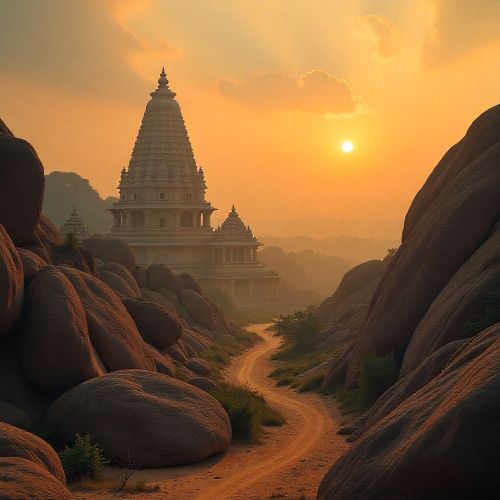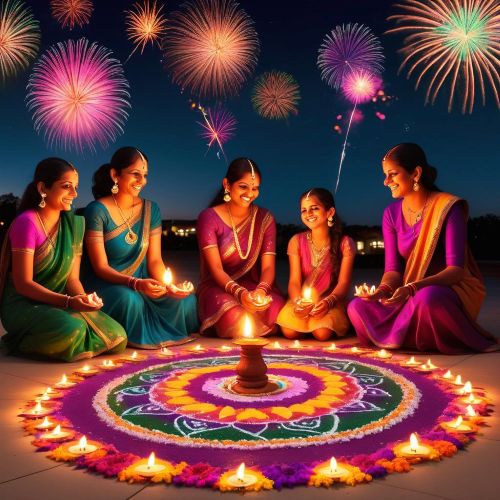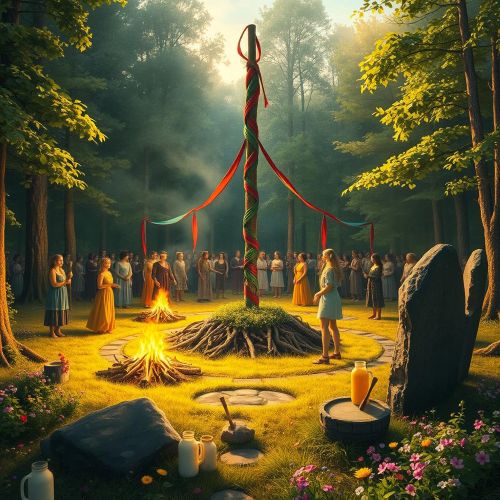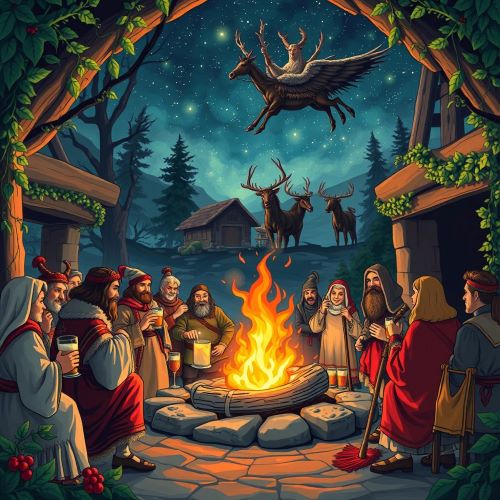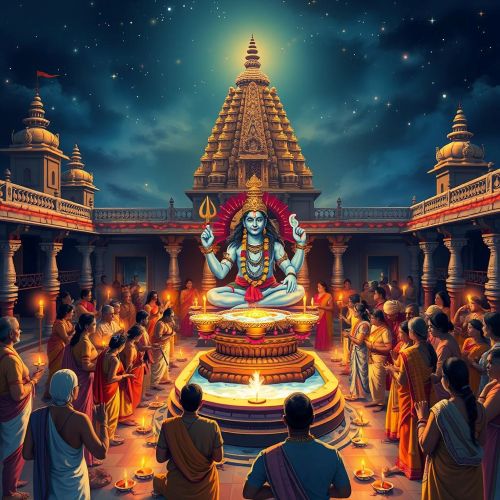Samhain : The Original Halloween
At a glance
| Description | |
|---|---|
| Location | Newgrange |
| Country | Ireland |
| Dedicated To | N/A |
| Duration | 1 day |
| Time of Year | 1 November |
Introduction
Samhain, pronounced “sow-in,” is an ancient Gaelic festival marking the transition from the harvest season to winter. Celebrated from October 31st to November 1st, it is a time of reflection, honoring ancestors, and acknowledging the supernatural. Gaelic traditions view this period as one where the boundary between the living and the spirit world is at its thinnest, allowing for interactions with otherworldly beings. Rooted in mythology, Samhain is associated with both seasonal change and the mysteries of life and death. Its influence persists in modern celebrations, including Halloween.
Connection with Mythology
Samhain plays a pivotal role in Irish mythology, serving as a bridge between the mortal realm and the supernatural. It predates Christian influences and is deeply tied to Celtic pagan traditions, marking the transition from harvest to winter. During this time, the veil between worlds was believed to be at its weakest, allowing spirits, fairies, and other mystical beings to move freely among the living.
Legends tell of eerie encounters during Samhain, including the ominous presence of the Dullahan, a headless horseman who roamed the countryside, foretelling death. Other figures, such as the Dagda, a god of abundance and power, were linked to the festival, as he was said to wield control over life and death. The Morrigan, a formidable goddess of war and destiny, was also closely tied to this time of transition, embodying the themes of fate and transformation that defined Samhain’s mythological significance.
Main Activities
Samhain was observed with a variety of rituals, emphasizing its role as a period of transition and spiritual connection. Central to the celebrations were bonfires, which symbolized protection and renewal. These communal fires were believed to ward off malevolent spirits, and embers from them were often used to relight household hearths, ensuring warmth and safety for the coming winter.
Feasting played a significant role, with communities gathering to share meals made from the season’s final harvest. To honor wandering spirits and ancestors, food and drink were set outside as offerings, a tradition that evolved into the practice of leaving treats for the dead.
Divination was also a key aspect of Samhain, as people sought insights into the future through various methods such as dream interpretation and the casting of lots. Another notable custom was guising—wearing disguises to blend in with spirits roaming the night, a practice that later influenced modern Halloween traditions.
Importance in Cultural History
Samhain was a pivotal festival in Gaelic societies, marking the transition between the old and new year. It was one of the four quarter days in the medieval Gaelic calendar and held deep spiritual and communal importance. Beyond its agricultural significance, Samhain fostered a sense of unity, reinforcing ancestral connections and cultural identity.
The festival’s influence persisted despite the spread of Christianity, which sought to integrate its themes into All Saints’ Day and All Souls’ Day in the 9th century. Many original customs endured, blending into evolving traditions that shaped modern Halloween. The themes of Samhain—death and rebirth, the balance of light and darkness, and the connection between the mortal and supernatural realms—continue to resonate in folklore, literature, and contemporary celebrations.
International Appeal
Samhain’s legacy extends far beyond its Gaelic roots, influencing celebrations worldwide. While Halloween has evolved into a largely secular and commercial holiday, many of its customs—such as dressing in costumes, carving pumpkins, and trick-or-treating—can be traced back to ancient Samhain traditions. Today, Halloween is widely observed in countries like the United States, Canada, and the United Kingdom, each incorporating regional variations while maintaining echoes of the past.
Beyond Halloween, Samhain has seen a revival among modern Pagan, Wiccan, and Celtic Reconstructionist communities. These groups honor the festival as a sacred time for ancestor veneration, spiritual reflection, and seasonal transition. Rituals often include bonfires, feasts, and ceremonies that align with traditional Gaelic beliefs, emphasizing a deeper connection with nature and the cycles of life and death. This resurgence reflects a broader movement to reclaim and preserve indigenous cultural traditions in contemporary spiritual practices.
Source
Hutton, Ronald. “The Stations of the Sun: A History of the Ritual Year in Britain.” Oxford University Press, 1996.
MacCulloch, John Arnott. “The Religion of the Ancient Celts.” Constable and Company Ltd., 1911.
O’Driscoll, Robert. “The Celtic Consciousness.” George Braziller, 1981.
Green, Miranda. “Celtic Myths.” University of Texas Press, 1995.
“Samhain.” Britannica. Accessed February 27, 2025.
“Samhain: Rituals, Traditions, and History.” Accessed February 27, 2025.
“Samhain: An Overview of the Ancient Festival.” Celtic Studies Resources. Accessed February 27, 2025.
Frequently Asked Questions
Lorem ipsum dolor sit amet, consectetur adipiscing?
Lorem ipsum dolor sit amet, consectetur adipiscing elit. Praesent convallis vestibulum justo, ac tincidunt nunc vehicula quis. Nullam id dolor quis orci malesuada feugiat. Curabitur aliquet libero at urna ullamcorper, ac ultricies nulla dapibus.
Lorem ipsum dolor sit amet, consectetur adipiscing?
Lorem ipsum dolor sit amet, consectetur adipiscing elit. Praesent convallis vestibulum justo, ac tincidunt nunc vehicula quis. Nullam id dolor quis orci malesuada feugiat. Curabitur aliquet libero at urna ullamcorper, ac ultricies nulla dapibus.
Lorem ipsum dolor sit amet, consectetur adipiscing?
Lorem ipsum dolor sit amet, consectetur adipiscing elit. Praesent convallis vestibulum justo, ac tincidunt nunc vehicula quis. Nullam id dolor quis orci malesuada feugiat. Curabitur aliquet libero at urna ullamcorper, ac ultricies nulla dapibus.
Lorem ipsum dolor sit amet, consectetur adipiscing?
Lorem ipsum dolor sit amet, consectetur adipiscing elit. Praesent convallis vestibulum justo, ac tincidunt nunc vehicula quis. Nullam id dolor quis orci malesuada feugiat. Curabitur aliquet libero at urna ullamcorper, ac ultricies nulla dapibus.
Lorem ipsum dolor sit amet, consectetur adipiscing?
Lorem ipsum dolor sit amet, consectetur adipiscing elit. Praesent convallis vestibulum justo, ac tincidunt nunc vehicula quis. Nullam id dolor quis orci malesuada feugiat. Curabitur aliquet libero at urna ullamcorper, ac ultricies nulla dapibus.




